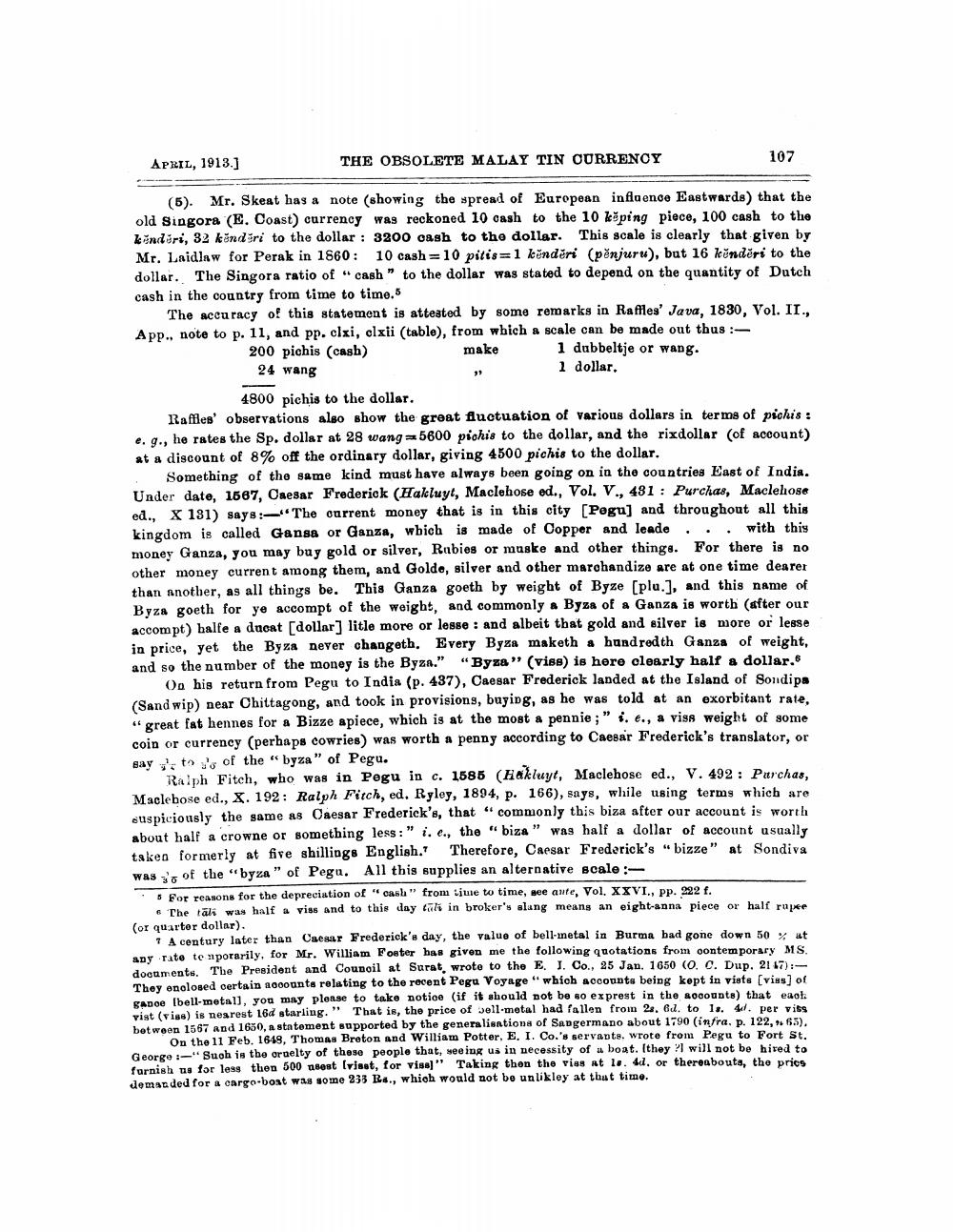________________
THE OBSOLETE MALAY TIN CURRENCY
107
APRIL, 1913.]
(5). Mr. Skeat has a note (showing the spread of European influence Eastwards) that the old Singora (E. Coast) currency was reckoned 10 cash to the 10 keping piece, 100 cash to the kenderi, 32 kendiri to the dollar: 3200 cash to the dollar. This scale is clearly that given by Mr. Laidlaw for Perak in 1860: 10 cash=10 pitis=1 kenderi (penjuru), but 16 kender to the dollar. The Singora ratio of "cash" to the dollar was stated to depend on the quantity of Dutch cash in the country from time to time.5
The accuracy of this statement is attested by some remarks in Raffles' Java, 1830, Vol. II., App., note to p. 11, and pp. clxi, clxii (table), from which a scale can be made out thus:1 dubbeltje or wang. 1 dollar.
200 pichis (cash)
make
24 wang
4800 pichis to the dollar.
Raffles' observations also show the great fluctuation of various dollars in terms of pichis: e. g., he rates the Sp. dollar at 28 wang-5600 pichis to the dollar, and the rixdollar (of account) at a discount of 8% off the ordinary dollar, giving 4500 pichis to the dollar.
Something of the same kind must have always been going on in the countries East of India. Under date, 1567, Caesar Frederick (Hakluyt, Maclehose ed., Vol. V., 481: Purchas, Maclehose ed., X 131) says:-The current money that is in this city [Pegu] and throughout all this kingdom is called Gansa or Ganza, which is made of Copper and leade... with this money Ganza, you may buy gold or silver, Rubies or muske and other things. For there is no other money current among them, and Golde, silver and other marchandize are at one time dearer than another, as all things be. This Ganza goeth by weight of Byze [plu.], and this name of Byza goeth for ye accompt of the weight, and commonly a Byza of a Ganza is worth (after our accompt) halfe a ducat [dollar] litle more or lesse : and albeit that gold and silver is more or lesse in price, yet the Byza never changeth. Every Byza maketh a hundredth Ganza of weight, and so the number of the money is the Byza." "Byza" (viss) is here clearly half a dollar.
On his return from Pegu to India (p. 437), Caesar Frederick landed at the Island of Sondipa (Sand wip) near Chittagong, and took in provisions, buying, as he was told at an exorbitant rate, "great fat hennes for a Bizze apiece, which is at the most a pennie;" . e., a viss weight of some coin or currency (perhaps cowries) was worth a penny according to Caesar Frederick's translator, or say to of the "byza" of Pegu.
Ralph Fitch, who was in Pegu in c. 1585 (Hakluyt, Maclehose ed., V. 492: Purchas, Maclebose ed., X. 192: Ralph Fitch, ed. Ryley, 1894, p. 166), says, while using terms which are suspiciously the same as Caesar Frederick's, that "commonly this biza after our account is worth about half a crowne or something less:" i. e., the "biza" was half a dollar of account usually taken formerly at five shillings English. Therefore, Caesar Frederick's "bizze" at Sondiva was of the "byza" of Pegu. All this supplies an alternative scale :
5 For reasons for the depreciation of "cash" from time to time, see ante, Vol. XXVI., pp. 222 f.
The tali was half a viss and to this day tali in broker's slang means an eight-anna piece or half rupee (or quarter dollar).
7 A century later than Caesar Frederick's day, the value of bell-metal in Burma had gone down 50% at any rate temporarily, for Mr. William Foster has given me the following quotations from contemporary MS. documents. The President and Council at Surat, wrote to the E. J. Co., 25 Jan. 1650 (O. C. Dup. 2147):They enclosed certain accounts relating to the recent Pegu Voyage" which accounts being kept in vists [viss] of ganoe [bell-metall, you may please to take notice (if it should not be so exprest in the accounts) that each That is, the price of sell-metal had fallen from 2s. 6d. to 1s. 4. per viss vist (viss) is nearest 16d starling. between 1567 and 1650, a statement supported by the generalisations of Sangermano about 1790 (infra. p. 122,65). On the 11 Feb. 1648, Thomas Breton and William Potter, E. I. Co.'s servants. wrote from Pegu to Fort St. George: Such is the cruelty of these people that, seeing us in necessity of a boat. (they I will not be hired to furnish us for less then 500 usest [visst, for viss]" Taking then the viss at le. 4d. or thereabouts, the pries demanded for a cargo-boat was some 233 Rs., which would not be unlikley at that time.




